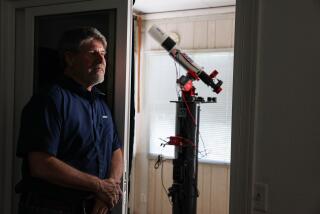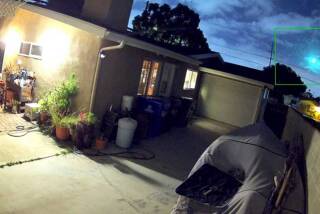Supernova blast emitted record burst of gamma rays
- Share via
Astronomers have chronicled a record-setting burst of gamma rays from the violent death throes of a relatively nearby massive star that imploded into a black hole.
The duration of the event -- on the order of hours -- as well as the number of photons created, the energy of those photons and the total explosive energy and radiance “topped the charts” for gamma ray bursts recorded by NASA and its international peers, said Paul Hertz, director of NASA’s astrophysics division.
“This burst was a once-in-a-century cosmic event,” Hertz said during an international media briefing Thursday.
“It’s much more than the energy that the sun has emitted in its whole life,” said Stanford University astrophysicist Nicola Omodei, one of the authors of a series of studies analyzing the gamma ray burst published online Thursday in the journal Science.
“Most of this energy was released in just a few tens of seconds, then the source slowly began to decay away,” added fellow Stanford astrophysicist Giacomo Vianello.
The relative proximity and magnitude of the event, detected April 27, gave numerous satellites and land-based observatories an ideal opportunity to collect a long stream of data on gamma ray burst 130427A, as the event was dubbed.
Teams spread over many countries were able to reposition space-based instruments toward the radiation beams. Among the craft involved were the Fermi Gamma-ray Space Telescope, with its Large Area Telescope, and Swift, a NASA satellite equipped with several telescopes to detect gamma, X-ray, ultraviolet and visible radiation. The RAPTOR system of linked, robotic telescopes was among the ground-based facilities that recorded the event.
Months of analysis by these research teams provided an unprecedented opportunity to double-check the prevailing theoretical framework for the basic physics of such bursts. So far, some of the math is not working out quite as expected.
“We measured events at very high energy that challenge traditional modeling” of gamma ray bursts, Omodei said.
Gamma ray bursts are something of the firefly of the astronomy world - very brief but intense radiation events that occur in every reach of the known universe with near daily regularity. They are the highest-energy events since the Big Bang and offer windows into the late stages of different kinds of stars and into the genesis of black holes. But they often are so distant they are hard to analyze.
The gamma radiation is produced by processes involving shock waves from material ejected by the black hole “engine” that was formed when the star collapsed. “Shells” of material traveling at different speeds -- all very close to the speed of light -- pile up on one another, like snow in front of a shovel, creating internal shocks that emit low-energy gamma photons. The lead edge of the beam also collides with the interstellar medium, producing a massive external shock and emitting high-energy gamma rays, X-rays, visible light and other radiation, known as the afterglow.
Scientists believed that much of the energy of the afterglow could be explained by “synchrotron shock,” in which particles accelerated by the shocks interact with magnetic fields and cast off high-energy photons.
There is a theoretical limit to the amount of energy that ought to be emitted by such synchrotron radiation, and that limit appears to have been shattered during the event. The apparent anomaly leaves astrophysicists reconsidering their assumptions about the energy sources and internal dynamics of gamma ray bursts.
“The assumptions must give,” said astrophysicist Chryssa Kouveliotou of NASA’s Marshall Space Flight Center in Huntsville, Ala. “Something must break. A fundamental physical process has been challenged.”
In case you missed the explosion, you’re not alone. It didn’t actually “happen” April 27. That’s when the radiation was detected. It probably took about 3.75 billion years to reach our galaxy. That long ago, the crust had barely solidified on Earth. In space-time terms, that’s still closer than most such events, many of which can be 10 billion light-years away.







